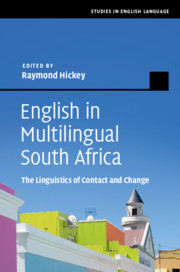Book contents
- English in Multilingual South Africa
- Studies in English Language
- English in Multilingual South Africa
- Copyright page
- Contents
- Figures
- Maps
- Tables
- Contributors
- Preface
- I A Framework for English in South Africa
- II Sociolinguistics, Globalisation and Multilingualism
- Chapter 7 Language Contact in Cape Town
- Chapter 8 Internal Push, External Pull: The Reverse Short Front Vowel Shift in South African English
- Chapter 9 Youth Language in South Africa: The Role of English in South African Tsotsitaals
- Chapter 10 Econo-Language Planning and Transformation in South Africa: From Localisation to Globalisation
- Chapter 11 Multilingualism in South African Education: A Southern Perspective
- III Language Interfaces
- Timeline for South African History
- Glossary
- Index
- References
Chapter 9 - Youth Language in South Africa: The Role of English in South African Tsotsitaals
from II - Sociolinguistics, Globalisation and Multilingualism
Published online by Cambridge University Press: 07 November 2019
- English in Multilingual South Africa
- Studies in English Language
- English in Multilingual South Africa
- Copyright page
- Contents
- Figures
- Maps
- Tables
- Contributors
- Preface
- I A Framework for English in South Africa
- II Sociolinguistics, Globalisation and Multilingualism
- Chapter 7 Language Contact in Cape Town
- Chapter 8 Internal Push, External Pull: The Reverse Short Front Vowel Shift in South African English
- Chapter 9 Youth Language in South Africa: The Role of English in South African Tsotsitaals
- Chapter 10 Econo-Language Planning and Transformation in South Africa: From Localisation to Globalisation
- Chapter 11 Multilingualism in South African Education: A Southern Perspective
- III Language Interfaces
- Timeline for South African History
- Glossary
- Index
- References
Summary
In interactions with their peers, South African male youths use a way of talking that is different from the local varieties spoken in their communities. Labelled tsotsitaals, this practice involves inserting a slang lexicon into the syntactic base of a local language combined with other paralinguistic features. Most studies of this phenomenon have looked at Afrikaans and Bantu language-based tsotsitaals but there are also several instances of English-based tsotsitaals among male youths in English-speaking communities. Across all tsotsitaals, English-derived words make up a substantial part of the slang lexicon. Ethnographic studies among young men who use Bantu-based tsotsitaals show that English plays a key role in indexing different identities. Based on the social meanings they attribute to English use, they incorporate English in a variety of ways making up different styles of tsotsitaal. These styles reflect different social levels, identities, attitudes and aspirations. The way English is incorporated into tsotsitaals challenges common approaches that treat this performance register as an autonomous referential system.
Keywords
- Type
- Chapter
- Information
- English in Multilingual South AfricaThe Linguistics of Contact and Change, pp. 176 - 195Publisher: Cambridge University PressPrint publication year: 2019
References
- 5
- Cited by

